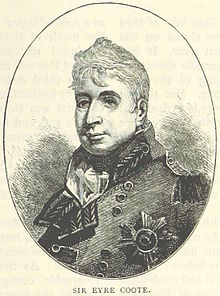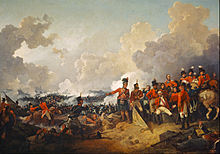Eyre Coote (British Army officer, born 1762)
Eyre Coote | |
|---|---|
 An 1895 illustration of Coote | |
| Governor of Jamaica | |
| In office 1806–1808 | |
| Preceded by | Sir George Nugent, 1st Baronet |
| Succeeded by | William Montagu, 5th Duke of Manchester |
| Personal details | |
| Died | 10 December 1823 (aged 61) |
| Spouses |
|
| Children | Catherine, Sarah and Susannah and Eyre Coote. |
| Parents |
|
| Alma mater | Trinity College Dublin |
| Military career | |
| Allegiance | |
| Service | |
| Rank | General |
| Battles / wars | American War of Independence French Revolutionary Wars |
Eyre Coote (20 May 1762 – 10 December 1823) was an Irish-born British soldier and politician who served as Governor of Jamaica. He attained the rank of general in the British Army and was created a Knight Grand Cross of the Order of the Bath before being stripped of his rank and honours in 1816 after conduct unbecoming an officer and a gentleman.
Background
[edit]He was the second son of the Very Rev. Charles Coote (1713 – 12 February 1776), DD, Dean of Kilfenora and wife (m. 31 July 1753) Grace Tilson (- 1 January 1767), brother of Charles Henry Coote (1754–1823), who succeeded the last Earl of Mountrath as 2nd Baron Castle Coote in 1802, and nephew of Sir Eyre Coote, KB, the celebrated Indian General, to whose vast estates in England and Ireland he eventually succeeded.
Career
[edit]
Following studies at Eton and Trinity College Dublin,[1] Coote purchased a commission in 1774 as an ensign in the 37th Regiment of Foot, of which his uncle Lieutenant- General Sir Eyre Coote was colonel.[2]
His regiment embarked for North America to fight in the American War of Independence, and he carried the colours at the Battle of Long Island on 27 August 1776. He was then promoted lieutenant, and served with that rank at York Island, Rhode Island, the expedition to the Chesapeake, and the battles of Brandywine, Germantown, and Monmouth Court House. He was promoted captain on 10 August 1778, and served in the campaign in New York in 1779, at the siege of Charleston in 1780, and finally throughout Lord Cornwallis's campaigns in Virginia up to the capitulation of Yorktown, when he became a prisoner.[2]
After his release he returned to England, and became major of the 47th Foot Regiment in 1783, and lieutenant-colonel of the 70th Foot in 1788. In 1793, on the outbreak of the war with France, he accompanied Sir Charles Grey on campaign to the West Indies in command of a battalion of light infantry, formed from the light companies of the various regiments in the expedition, and greatly distinguished himself throughout the operations there, and especially at the storming of the Morne Fortuné in Guadeloupe, for which he was thanked in general orders.[3]
Coote was promoted colonel on 24 January 1794, and returned with Sir Ralph Abercromby in 1795 to the West Indies, where he again distinguished himself, and for his services was made an aide-de-camp to King George III. In 1796 he was made a brigadier-general, and appointed to command the camp at Bandon in Ireland, and on 1 January 1798 he was promoted major-general, and shortly after given the important command of Dover.[2]
As Coote held the Dover post he was appointed to command the troops employed in the expedition which had been planned by Sir Home Popham to cut the sluices at Ostend, and thus flood that part of the Netherlands which was then in the possession of the French. The troops were only thirteen hundred in number, and were successfully disembarked and cut the sluices as proposed on 18 May. A high wind off the land then sprang up, and the ships could not come in to take the troops off. French troops were hurried up, and the small English force was completely hemmed in, and after a desperate resistance, in which he lost six officers and 109 men killed and wounded, Coote, who was himself severely wounded, was forced to surrender. He was soon exchanged, and then returned to his command at Dover, but was summoned from it in 1799 to command a division in the Anglo-Russian invasion of Holland.[2]
Coote's and Don's division formed Sir James Pulteney's column in the fierce battle of Bergen, but the successes of Pulteney's and Abercromby's columns could not make up for the failure of the rest, and Frederick, Duke of York had to sign the Convention of Alkmaar.[2]

In 1800, Coote was appointed to command a brigade in the Mediterranean, and bore his part in the disembarkation of Sir Ralph Abercromby in Egypt and in the battles there of 8, 13, and 21 March. When Sir John Hutchinson, who succeeded Sir Ralph Abercromby, commenced his march to Cairo, Coote was left in command before Alexandria, and conducted the blockade of that city from April to August 1801.[4] Coote appears as one of the Heroes of the Egypt Campaign in a commemorative engraving of 1802.[5]
In the latter month General Hutchinson rejoined the army before Alexandria, and determined to take it. He ordered Coote to take two divisions round to the west of the city, and to attack the castle of Marabout, which commanded it. Victory at the Battle of Alexandria followed; Coote took Marabout after a stubborn resistance, and Alexandria surrendered. His services in Egypt were so conspicuous that Coote was made a Knight of the Bath, and also a knight of the new order of the Crescent by the Sultan.[6]
Coote was appointed to command an expedition which was to assemble at Gibraltar for service against South America. This expedition, however, was stopped by the Peace of Amiens, and Coote returned to England, and in 1802 he was elected M.P. for Queen's County, in which he possessed large property inherited from the more famous Sir Eyre Coote (1726–1783). He had already represented, in the Irish House of Commons, Ballynakill (1790–1797) and Maryborough (1797–1800). He did not sit long in the House of Commons at this time, for in 1805 he was promoted lieutenant-general, and appointed lieutenant-governor and commander-in-chief of Jamaica. In April 1808, he resigned his government from ill-health, for the West Indian climate greatly tried his constitution and affected his brain.[6]
Nevertheless, he was appointed second in command to Lord Chatham in 1809, when the Walcheren expedition was projected, and he superintended all the operations of the siege of Flushing until its surrender. His proceedings, however, were so eccentric during the expedition, that it was obvious that he could never again be trusted with a command.[6]
He was colonel of the 62nd Foot (1806–1810) and the 34th (Cumberland) Regiment of Foot (1810–1816), elected M.P. for Barnstaple in 1812, and promoted general in 1814. His conduct became more and more eccentric, and as "William Cooper" describes in his Flagellation and the Flagellants: A History of the Rod,[a] in November 1815, he entered Christ's Hospital school for boys and offered some boys money for an opportunity to flog them. After that he asked them to flog him and rewarded them with money. Caught by the school nurse, he was charged for indecent conduct. On 25 November 1815, he was brought up at the Mansion House before the Lord Mayor of London on the charge, and acquitted after "donating" £1000 to the school.[6][7] [8][9]
Although the case had been dismissed, the Duke of York, the commander-in-chief of the British Army, heard of these proceedings, and, in spite of strong representations from many distinguished officers, he directed Sir John Abercromby, Sir Henry Fane, and Sir George Cooke to report upon the matter. These three generals, after a long inquiry, reported that Coote was eccentric, not mad, and that his conduct had been unworthy of an officer and a gentleman. On 21 May 1816, Coote was removed from his regiment, dismissed from the army, and degraded from the Order of the Bath.[6][7][9]
Coote lost his seat in parliament at the dissolution of 1818, and died on 10 December 1823. [6]
Family
[edit]He had eight children with three women and was twice married: first to Sarah (1765–1795), daughter of John Rodbard, left three daughters – Catherine, Sarah and Susannah; and second to Jane, daughter of Col. John Bagwell, left one son, Eyre Coote. Sarah Rodbard is the subject of one of George Romney's paintings.[citation needed]
Coote also had children with a Jamaican slave woman named Sally with whom he had four children. Susan Coote, born 1812, William Coote, born 1807, John Coote, born 1812 and Henry Coote, born 1818. [6][10]
Notes
[edit]- ^ William Cooper was a pseudonym of James Glass Bertram (1824–1892)
- ^ Alumni Dublinenses : a register of the students, graduates, professors and provosts of Trinity College in the University of Dublin (1593–1860), George Dames Burtchaell/Thomas Ulick Sadleir p. 176: Dublin, Alex Thom and Co, 1935
- ^ a b c d e Stephen 1887, p. 161.
- ^ Stephen 1887, p. 161 see: Military Panorama for May 1813.
- ^ Stephen 1887, pp. 161–162.
- ^ Black Watch Museum, Perth.
- ^ a b c d e f g Stephen 1887, p. 162.
- ^ a b Cooper 1869, pp. 522–527.
- ^ Chandos 1984, pp. 236–237.
- ^ a b Thorne 1986, p. 499.
- ^ University of Michigan, William L Clements Library, Eyre Coote Papers 1775-1925: Biography
References
[edit]- Chandos, John (1984). Boys together: English public schools, 1800–1864. Hutchinson. pp. 236–7. ISBN 0-09-139240-3.
- Cooper, William (1869). History of the Rod. Flagellation and the Flagellants. John Camden Hotten. pp. 522–527.
- Thorne, R. G. (1986). The House of Commons, 1790–1820, Volume 3. Boydell & Brewer. p. 499. ISBN 0-436-52101-6.
- Attribution
 This article incorporates text from a publication now in the public domain: Stephen, Leslie, ed. (1887). "Coote, Eyre (1762-1824?)". Dictionary of National Biography. Vol. 12. London: Smith, Elder & Co. p. 161–162. Endnotes:
This article incorporates text from a publication now in the public domain: Stephen, Leslie, ed. (1887). "Coote, Eyre (1762-1824?)". Dictionary of National Biography. Vol. 12. London: Smith, Elder & Co. p. 161–162. Endnotes:
- European Mag., April 1810
- Military Panorama, May 1813
- A Plain Statement of Facts relative to Sir Eyre Coote, containing the official correspondence and documents connected with his case, London 1816.
External links
[edit]- Hansard 1803–2005: contributions in Parliament by Eyre Coote
- 1762 births
- 1823 deaths
- Alumni of Trinity College Dublin
- American Revolutionary War prisoners of war held by the United States
- British Army generals
- British Army personnel of the American Revolutionary War
- British Army personnel of the French Revolutionary Wars
- British Army personnel of the Napoleonic Wars
- British prisoners of war in the American Revolutionary War
- Coote family
- Governors of Jamaica
- Knights of the Order of the Crescent
- Irish MPs 1790–1797
- Irish MPs 1798–1800
- Members of the Parliament of Ireland (pre-1801) for Queen's County constituencies
- Members of the Parliament of the United Kingdom for Barnstaple
- Members of the Parliament of the United Kingdom for Queen's County constituencies (1801–1922)
- People stripped of a British Commonwealth honour
- 34th Regiment of Foot officers
- UK MPs 1802–1806
- UK MPs 1812–1818
